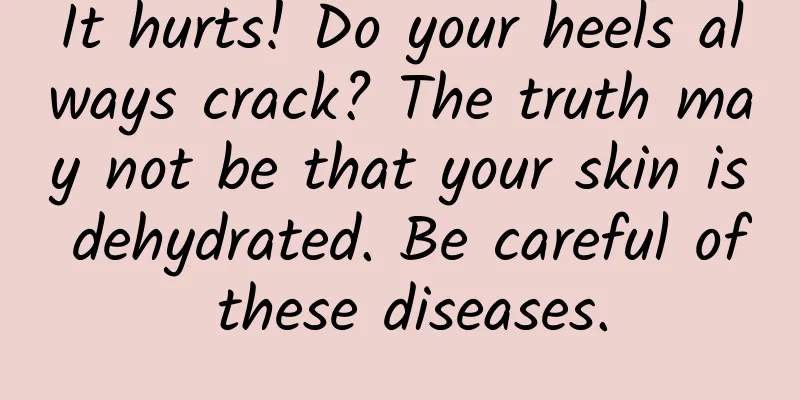It hurts! Do your heels always crack? The truth may not be that your skin is dehydrated. Be careful of these diseases.

|
When autumn and winter arrive, the skin on many people's feet becomes dry, and cracks appear on the heels. Cracked heels not only affect the appearance, but the most unbearable thing is that if they are not treated in time, they may cause infection. In severe cases, you will feel pain at the crack every time you take a step. Some netizens joked, "It's really like walking with tears" and "Every step is startling"... Cracked heels (Source reference) So, what causes cracked heels? How to prevent and relieve them? Next, we will share with you many effective methods to help you solve the problem of cracked heels at home. Cracked heels are not only caused by dryness These diseases may also be hidden dangers Cracked heels, as the name implies, are dry, fissured or cracked skin on the heels. These cracks can be mild or severe and are sometimes accompanied by hyperkeratosis, which is thickening of the skin with a callous-like texture. When these cracks penetrate deep into the dermis, they can cause pain. Under normal circumstances, our skin is soft and maintains proper moisture and elasticity, including the skin on the soles of the feet, which can cope with the friction, compression and shear stress imposed on it during weight bearing. However, when the skin lacks moisture and is subjected to frequent and high-intensity friction and pressure, it is easy to become dry, rough and cracked. To expand on this, here are some common causes of cracked heels: · Dry skin or xeroderma: The skin lacks moisture or natural oils, causing it to dry out and crack. Cold, dry weather: Low temperatures and low humidity in fall and winter often exacerbate dryness on the skin of the feet. · Standing or walking for long periods of time: Standing or walking for long periods of time may increase the pressure on the soles of the feet and cause the skin on the heels to crack. Wearing open-heel shoes: Shoes with open heels, such as sandals, cannot effectively support the feet and can easily lead to dry and cracked heels. · Being overweight or obese: This can cause excessive pressure on the heels. In addition to the common reasons mentioned above, we should be aware that some diseases can also cause dry and cracked heels, such as diabetes, hypothyroidism, etc. Literature shows that the proportion of diabetic patients with dry and cracked heels can reach 31%. It should also be noted that tinea pedis (commonly known as athlete's foot) caused by fungal infection may occasionally cause dry and cracked heels, but at the same time, there are usually changes such as itching, abnormal redness, blisters, and rotten toes. It is rarely just dry and cracked heels. If tinea pedis is suspected, antifungal treatment should be carried out, and it is not appropriate to treat it as ordinary dry and cracked heels. There are some symptoms of cracked heels The symptoms of cracked heels vary from person to person, and can range from mild to severe. Some people will have further aggravation in the later stages, with linear cracks and fissures appearing , and the cracks may even gradually deepen. At this time, the patient may feel pain and discomfort, especially when walking or standing. In more serious cases, the cracks may bleed, form blood scabs , or even become infected. Severe cracked heels (from references) 4 ways to relieve cracked heels at home There are three main countermeasures for heel pain: 1. Try to avoid the causes and factors that may aggravate the disease, which will also help reduce future recurrences. Second: Pay attention to protecting local skin and reducing mechanical damage to prevent the condition from getting worse. 3. Strengthen local moisturizing and repair of the skin, and actively improve the local microenvironment of the skin. Based on this, we have sorted out 4 measures to deal with cracked heels: · Moderate foot soaking: You can soak your feet in warm water for about 10 minutes every day (no more than 20 minutes) to help soften abnormally thickened cuticles. · Proper removal of hard and dead skin: Depending on the condition of thickened keratin, use tools such as pumice stone to gently remove the hard and dead skin on the heels from time to time. · Functional products: Apply products with medicinal effects, such as those containing urea, alpha-hydroxy acid, salicylic acid, lactic acid, etc. These products often help replenish skin moisture or reduce water loss and soften hard skin. · Post-moisturizing care: Before going to bed, you can apply ointment such as Vaseline or moisturizing cream to further increase the moisturizing and moisture-sealing effects. The above solutions are only some of the relatively mainstream treatment options, not all, so they are for reference only. In addition, if the effect of self-treatment at home is not obvious, or there are serious cracks or suspected infections, it is recommended to seek professional help in time. The doctor may take other additional treatment measures, such as: Bandaging: Bandaging to prevent skin movement. Prescription medications: Your doctor may prescribe other prescription medications (topical medications) that are stronger than commercial products and contain higher concentrations of active ingredients, such as high-concentration salicylic acid preparations. Skin glue: If necessary, your doctor may use a glue specifically for skin application (usually cyanoacrylate) to hold the two sides of the tear in place and help it heal. Pay attention to 4 points to effectively prevent heel cracking We all know that prevention is better than cure. If we don’t take good daily precautions, cracked heels may return in the autumn and winter of next year. Therefore, in order to keep your feet healthy, you can learn some measures to prevent cracked heels in advance, mainly including: 1. Focus on local moisturizing: Strengthen local moisturizing, especially in cold and dry seasons. Generally, ointments, creams and lotions are all fine, among which ointments and creams are more moisturizing. 2. Wear suitable shoes: Avoid wearing shoes that expose the heels. It is recommended to choose shoes that are suitable, comfortable and can support the soles of the feet. 3. Choose the right insoles: Some insoles can help alleviate the problem by redistributing pressure on the heel. Try to avoid using insoles that are of poor quality, too hard or have no support. 4. Avoid standing or walking for long periods of time: If circumstances permit, you can reduce long periods of standing or walking, mainly to reduce the burden on your feet (including your heels). The above are some ways to deal with the problem of cracked heels. I wish everyone in front of the screen that every step in the future will be easy and free, and stay away from the trouble of cracked heels. References [1] Nipanikar SU, Mundhe NB, Gajare KV, et al. Evaluation of efficacy and safety of Amarantha footcare cream in subjects suffering from cracked heels (xerosis of the feet): A randomized, open labeled, multi-centric, comparative, interventional, prospective, clinical study[J]. Journal of Indian System of Medicine, 2023, 11(1): 14-20. [2] Wadekar PH, Potnis V. A Review on Heel Fissures and its Management. International Journal of Research in Engineering, Science and Management. 2021, 4(2): 96-98. [3] Weerasekera KR, Kanthi DGS, Kanthilatha HG. Indigenous medicine intervention in management of padadari (Cracked Heel): A case study. International Journal of AYUSH Case Reports. 2023, 7(3): 257-261. [4] Mayoclinic. How to heal cracked heels. https://www.mayoclinic.org/diseases-conditions/dry-skin/expert-answers/cracked-heels-treatment/faq-20455140 [5] WebMD. What to know about cracked heels. https://www.webmd.com/skin-problems-and-treatments/what-to-know-cracked-heels [6] AAD. How to care for dry, cracked heels. https://www.aad.org/public/everyday-care/skin-care-basics/dry/dry-heels [7] DermNet. Cracked heel. https://dermnetnz.org/topics/cracked-heel Planning and production Author: Tang Jiaoqing, attending physician of dermatology department Review | Feng Jun, Deputy Chief Physician, Dermatology Department, General Hospital of Datong Coal Mine Group Co., Ltd. Planning丨Zhong Yanping Editor: Zhong Yanping Proofread by Xu Lailinlin |
>>: Grab the tickets! How will 12306 face the "big test"?
Recommend
How to increase the number of likes on Tik Tok? How to increase the number of likes on Douyin?
There are many popular videos on Douyin with very...
Case Practice | Is scanning QR code for door-to-door marketing still effective in 2021?
It’s already 2021, is door-to-door QR code scanni...
5 strategies for membership marketing of knowledge payment APP
As people's copyright awareness gradually inc...
Baidu bidding promotion, master these 5 points
The competition in the Baidu bidding industry is ...
Sony WF-H800 Bluetooth Headphones Review: Youthful in Appearance, Steady in Performance
Since Apple launched AirPods, wireless earphones ...
Is there online fraud in the animal world? This is not about money but about life! | Species Chat
We often say that we should be careful of online ...
What is the difference between a smart business notebook and Honor MagicBook V 14 2022?
If we go back a few years, I believe people at th...
Internet marketing is full of traps. How can you avoid fifteen of them?
With the rapid development of the Internet, onlin...
Activity operation plan planning process
The activity planning process is divided into the...
How to design SEM account structure from 0 to 1?
Account structure is a difficult problem for begi...
Let's talk seriously about programmers' self-cultivation
Today, when I was browsing the Blog Park, I saw a...
This animal is physically disabled but extremely ferocious, with a lifespan of up to 4 centuries. It is the Greenland shark
“I mourn the brevity of my life and envy the infi...
[Original] Free promotion of APP with zero budget in the early stage, just do these 17 points!
Preface: I have been working for several years. I...
User operations in Internet finance: How to promote high orders and high conversions?
I. Four Behavioral Characteristics of Internet Fi...
2021 Team Value Investment Director Wu Muyang and Wu Muyang's Circle (Medium and Long-term Bands)
2021 Team Value Investment Director Wu Muyang and...









